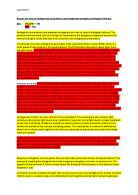Discuss the role of endogenous pacemakers and exogenous zeitgebers in the sleep/wake cycle, and at least one other biological rhythm
Discuss the role of endogenous pacemakers and exogenous zeitgebers
in the sleep/wake cycle, and at least one other biological rhythm
The sleep/wake cycle is a circadian rhythm, which means that it rotates a full cycle every 24 hours, and is controlled and regulated through endogenous pacemakers and exogenous zeitgebers. Endogenous pacemakers are inbuilt biological clocks that regulate our behaviour, such as the sleep/wake cycle, stages of sleep and the menstrual cycle. Exogenous zeitgebers, such as lights or clocks, keep us regulated with the outside world. It is believed that humans have many endogenous pacemakers, some of which have yet to be identified. In this essay I will be discussing research that helps us to understand the role and importance of endogenous pacemakers and exogenous zeitgebers.
The biological clock that regulates the sleep/wake cycle in mammals is called the Suprachiasmatic Nucleus (SCN), found in the primitive area of the brain, and the exogenous zeitgeber that acts upon it is light. When the optic nerves at the back of the eyes can sense light, the Suprachiasmatic Nucleus doesn’t function. But when the optic nerves sense a lack of light it sends a signal through the optic chiasm to the Suprachiasmatic Nucleus. The SCN then activates the pineal gland, which releases the hormone melatonin, making us feel tired and want to sleep. This shows us that although both endogenous pacemakers and exogenous zeitgebers are important, the pacemakers appear to be the dominant component in terms of regulating the cycle. Melatonin has also been found to stimulate the immune system, and it also regulates the production of hormones such as oestrogen and testosterone. If the SCN is damaged or connections from the eyes to the SCN are damaged or destroyed, this will mean that the circadian rhythm of the sleep wake cycle will disappear completely. There are multiple studies that support this and suggest the role of endogenous pacemakers, such as Morgan (1995). Morgan surgically removed the SCN from hamsters and found that their natural nocturnal behaviour had disappeared. He then removed the SCN’s from mutant diurnal hamsters and switched the SCN’s between the hamsters. He found that once the SCN’s were replanted, the non-mutant nocturnal hamster began to show mutant diurnal behaviour and vice versa. This shows us that the SCN is a key component in controlling the sleep/wake cycle. This is supported by a similar study conducted by Ralph et al (1990) which aimed to show that the SCN generates the circadian rhythm in mammals. He used a sample of hamsters, some of which had a genetic abnormality affecting their circadian rhythm. One group of hamsters was identified with a genetically abnormal 20-hour circadian cycle, rather than a 24-hour one. Their SCNs were then removed and placed in the brains of the experimental group of hamsters with a normal 24-hour cycle. The experimental group, after the transplant, had then switched from a normal 24-hour circadian rhythm to an abnormal 20-hour circadian rhythm. In conclusion, the results of both these studies show us that the circadian cycle of the hamsters was regulated by the SCN. However, both these studies raise questions about the ethics of animal research. We can use animals to study theories that would be impossible or even more unethical, to use human subjects in. These studies by Ralph and Morgan are a good example, they surgically removed the SCN’s from hamster’s brains, and it would be completely unethically to try this on humans. But this doesn’t mean that it is ethical to use animal subjects, animals can’t consent and most of the animals involved in animal testing will die. Also, we can control just about all of the parameters of the animal’s life, making the studies a lot more valid, and increasing ecological validity. But just because we are ‘superior’ to animals, does this mean we have right to do this? Some people will also argue that we have a lot of the same neural communications, neurons and synapses as animals especially rodents such as rats and hamsters. However only humans and a few higher mammals have true language, and this had a massive effect on our behaviour.








